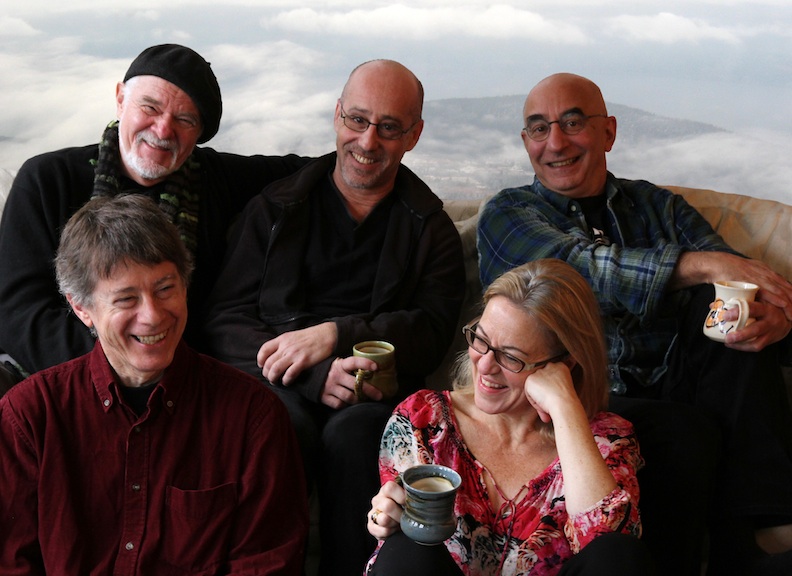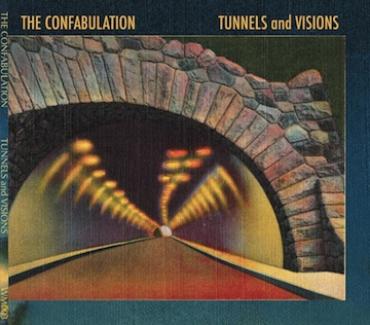Something a little different for me but still
containing some elements of folk, world music,
and lots of discreet 70's oriented
contemporary jazz -- The
Confabulation, a project
spear-headed by Toronto bassist/composer and
producer David Woodhead digs
deep for some inspired music and comes up with
a motherlode. There are plenty of compatible
musicians involved in this project who are
equally distinguished and contribute
significantly to "Tunnel and
Visions."

While I'm a little out of my realm I am
experienced enough to appreciate what these
talented people are trying to do and
achieve. So, if you're one of those record
buyers from the 70's who gambled on some of
those innovative cool Columbia, Verve, Blue
Note, CTI (Creed Taylor), ABC-Paramount,
Embryo, Cotillion, Command, Impulse, and
Mainstream jazz record releases this could
be a great walk down memory lane or just
finding the old neighborhood hasn't changed.
This is why I'm taking the time to
comment -- I remember those albums and why
some were exciting. The groups, trios,
ensembles, and experimenters. The Modern
Jazz Quartet was always premier but then
there was Gary Burton, Carla Bley, Dave
Brubeck, Klaus Dolinger's Passport and while
I will mention Sergio Mendes in the same
sentence as Thelonious Monk -- it's
because that's what defined that era. Jazz
buffs had those artists together -- maybe on
different shelves -- but never too far from
their turntable.
Al Hirt, Herb Alpert, Doc Severinsen,
albums produced by Creed Taylor -- ok,
they weren't Miles Davis, Don Cherry or Chet
Baker -- but they did further the trumpet
more than most great trumpet players.
Opening -- The Confabulation
starts off with trumpets, flute, and deep
bass much the same as some of the music
Carla Bley experimented with (the title
even suggests an influence by Bley). While a
little sublime, there is a melody to follow
for those who find jazz too avant-garde, too
out-there, too cool.
"Carnival for the Clocks,"
possesses some of that intricate
orchestrated instrumental interplay made
famous by German
composer-conductor Bert Kaempfert ("Afrikaan
Beat," "Happy Trumpeter") and
this is the value-added -- the attraction,
the arrangements. Then, there are moments
when there is a hint of Chuck Mangione
(though there is no flugelhorn on this) in
its simplicity and clearness. Slinky low
tone trombone (Tom Richards) coupled by the
high notes of a flute (Anh Phung) anchored
by deep bellows of tuba (Jay Burr) and bass
(Woodhead). Not earth-shattering jazz but a
pleasant listen with many shades throughout
to appreciate.
More piano-driven is "Futura
Bold" (a typeface if
I am not mistaken), has recollections
of the type (no pun intended) of jazz
melodies frequented by guitarist Pat
Metheny, John Abercrombie and Joe Pass with
a touch of the Paul Winter Consort to help
it from getting too heavy. The tenor sax
(Colleen Allen -- who played with Holly
Cole) adds a nice balance. The violin is a
little unorthodox in a jazz-setting but
this addition is well-executed if not too
brief. But on the third track "Mary
Sue," -- makes up for it
where Anne Lindsay's violin is featured
longer.
"Mary Sue" has that
late Jaco Pastorius bass feel that many of
Joni Mitchell's later songs possessed. This
actually almost sounds like a short melody that
Joni discarded without words during her period
where she tried to pursue a folky jazzy menu
that she tried to introduce to her reluctant
audiences in the 70's and 80's. This has a nice
exquisite performance.
"Precious Little Solves The
Riddle," is another title
that is Carla Bley oriented. Deep piano
notes is a nice diversity for the brass and
uppity background vocals (typical of Herb
Alpert and Sergio Mendes in the 60's). You
could say this is lounge-jazz, cocktail-jazz
but I would differ. There is a progression
here that suggests a noir-bossa-nova.
Emulating those artists is not a sin -- they
had some of the most melodic, wonderfully
played tunes in their day that took stabs at
Latin, Brazilian, island and calypso jazz
potpourri. Too bad many of those tunes never
made it to more ears. Alpert, for instance,
had a great melodic minor hit called "Flamingo,"
which should have been covered by many
instrumentalists.
So far, The Confabulation
is showing deft and clever diversity in
their performance and nothing they have
played is boring or contrived. I guess the
only drawback some may find is that it
harkens back to an era many have forgotten
and wish not to relive or consider theme
songs for game shows. But again, I would
have to disagree. Those songs and how some
here are reinvented, reshaped and
interpreted show how adaptable and
compatible the genre is. David Woodhead is
not going down memory lane nor is he tapping
into an old form. He is showing how a form
has matured and how it can continue to be
appreciated.
"Danse de Travers No. 3"
-- a Satie-Wilde composition with a
contribution by Woodhead features Bob Cohen
(Jesse Winchester) on nylon string guitar as
the other musicians frame the performance
mildly. No showboating, just layers of warm
instrumentation. Anne Lindsay's violin is
featured prominently but again, briefly. Of
course, this is more classical than jazz or
cabaret. Colleen Allen's clarinet and her
flute are delicate and as well, brief. The
tune is well-recorded but unfortunately,
everything is arranged economically. Back in
the old days of cassettes you could loop a
track and have it play seamlessly twice as
one long uninterrupted melody. All the
musicians on this track play with rich
delicacy.
"Late for Lunch,"
only features four musicians and is the
fieriest tune on the collection.
Jaron Freeman-Fox's violin has a similar
flare as violin-fiddle greats Richard Greene
(Seatrain, the Blues Project, Bill Monroe
and his Bluegrass Boys, Gary Burton) and/or
Jerry Goodman (The Flock, Mahavishnu
Orchestra).
Now, the eccentric "Inch
Worm," could be a little
distracting with the counting, though the
melody and performance were good, the
vocalizing was a little too old school for
my taste and bordered on The Ray Conniff
Singers. Perhaps a little listen to the far
more artistic Phillip Glass
opera "Einstein on the Beach,"
which started with a similar counting effort
but with intense overlapping voices. With
that in mind and married to the Frank
Loesser composition, it would have been a
little more compelling. The rest of the
instrumentation in the composition was
well executed.
Though not as dramatic as the original
score of the 1950's horror film "Godzilla,"
-- the influenced track "Gargantuas"
does offer a nice hat tip to the Toho
monster films and that genre music. This is
not exactly an idea a seasoned jazz musician
would tackle but at least it does not sound
like novelty music. I do respect the stretch
the musicians attempt to make it work. The
piano is excellent throughout as well as the
little spooky guitar effects (shades of Joe
Meek). There are indeed moments of Steely
Dan excursions which rescue this from being
discount-store fake jazz albums or Lounge
Lizards / Penguin Cafe Orchestra turf. Fortunately,
it is not similar to those Jackie Gleason
and David Carroll orchestrated collections
of drek. I will admit I like The
Confabulation's challenging
attitude. It's not a washout. I also enjoyed
the Blue Hawaiians when they tackled the
main theme (written by Henry Mancini) to the
film "Experiment in Terror."
Now if I could get someone to cover David
Seville's (that's right, Ross Bagdasarian --
the Chipmunk's guy) great piano-driven jazz
instrumental "Almost Good." Talk
about a lost classic and probably a great
tune to play live.
Changing gears the band opens "Windy
Apples," with a banjo
(David Woodhead). A nice left curve at the
crossroads of jazz and classical street.
This is what makes some musicians worth
listening to. The way they can just go from
a speeding sports car, to pick up truck, to
motorcycle in a flash. This has a
distinctive, pleasant sound to this
composition and there is (because of the
Doug Wilde piano) an undercurrent of jazz
along with the nice deep bass tones (David
again) and snap of guitar (Bob Cohen). It
shows how close folk music can touch the rim
of jazz and still be evocative. Great
acoustic guitar for balance. Great
tune.
Once again, somewhat rooted in the Pat
Metheny school "Grottos"
has some nice mannered jazz guitar but with
that Mahavishnu Orchestra mystique of the
70's when lead guitarist John McLaughlin led
them. Just here, not as flashy and
explosive.
This has to be listened to, to be
appreciated. The musicians all come together
very strategically, layered, and smartly.
The saxes, guitars, violin, organetto,
piano, and I like David Woodhead's bass here
-- once again in that beautiful Jaco
Pastorious fashion. This was a very
enjoyable five minutes...nothing else to say
but to relish it.
The final track "Permanent
Trees," has a title the
Paul Winter Consort would have liked. Nice
and upbeat, and a good way to close out the
LP. This tune has a somewhat Dave Brubeck
feel -- everything executed cleanly and the
song sounds like it could stimulate an even
greater jam on a live stage. It lends itself
to that kind of workout as it proceeds. All
the musicians are exceptional -- and it
leaves a listener wanting more which is what
the band and its marketers probably want
from its listeners. There was a pianist jazz
performer who never got his due but there is
a hint of his style here -- the late Scott
Bradford ("Kansas City Masher," "Mid-Evil
Dance," -- LP-Rock Slides, an
album that also featured sax player
Nathan Davis). A shame Scott
isn't alive today to hear this fine
55-minute collection.
The album was produced by David
Woodhead.
Website: http://www.davidwoodhead.com/confabulation.html
Facebook: https://www.facebook.com/The-Confabulation-786207938065779/?fref=ts
Disclaimer: The
opinions expressed in this
review/commentary are those of the author
and do not necessarily reflect the
official position of No Depression. All
photography is owned by the respective
photographers and is their copyrighted
image; credited where photographer's name
or studio was known & being used here
solely as a reference and will be removed
upon request. YouTube images & music
are standard YouTube license.
John Apice / No Depression /
August 2018*
 Cover Design by
David Woodhead // Group Color Image from
Website
Cover Design by
David Woodhead // Group Color Image from
Website 






